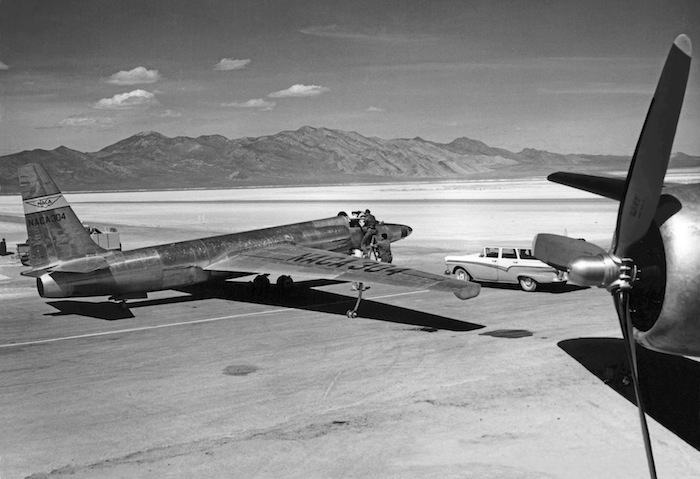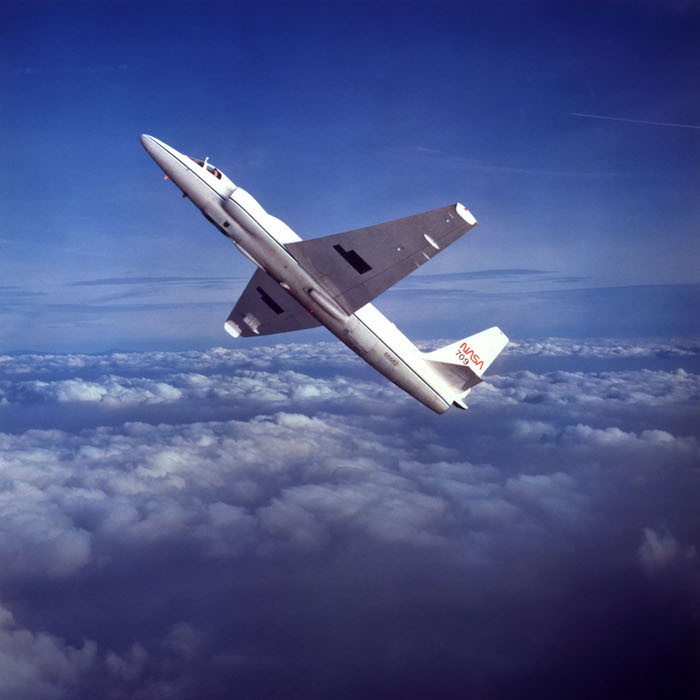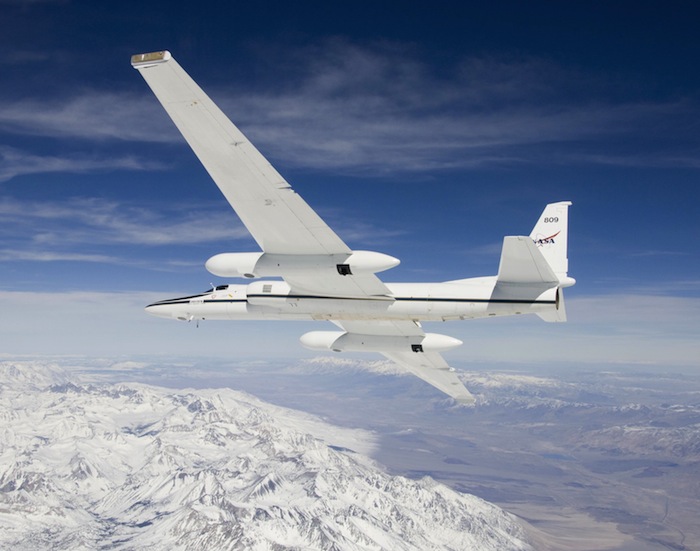.

Sixty years ago, a spindly silver airplane made its first flight in total secrecy. Designed by Lockheed Aircraft Corporation (now Lockheed Martin) as a spy plane for the Central Intelligence Agency (CIA), it has since evolved into a versatile platform for scientific research.
NASA operates two Lockheed ER-2 Earth resources aircraft – a variant of the U-2 – as flying laboratories in the Airborne Science Program under the agency's Science Mission Directorate. Both aircraft, based at NASA Armstrong's Building 703 in Palmdale, California, collect information about natural resources, celestial observations, atmospheric chemistry and dynamics, and oceanic processes. Capable of attaining altitudes above 70,000 feet, the aircraft are also used for electronic sensor research and development, satellite calibration, and satellite data validation.
.

Ground crewmen prepare a CIA U-2 for a training flight at Watertown Strip, Nevada. Note NACA markings on the wing and tail.
Credits: CIA Photo
.
Use of the U-2 as a civilian research platform began in February 1956, several months after the aircraft’s maiden flight from an isolated test site. Anticipating a surge in off-range training sorties and eventual overseas deployment, CIA officials devised a cover story to explain the airplane’s unique capabilities and disguise its true mission. This necessary fiction contained elements of truth that served as a foundation for later efforts in the field of airborne science.

Following an agreement between the CIA and the National Advisory Committee for Aeronautics, NASA’s predecessor, NACA director Hugh L. Dryden publicly announced a program in which U-2 aircraft would conduct high-altitude weather research with Air Force support while operating from Watertown Strip, Nevada. In order to explain the presence of U-2 operations elsewhere, Dryden added, “[Air Force] facilities overseas will be used as the program gets underway, to enable gathering research information necessary to reflect accurately conditions along the high-altitude air routes of tomorrow in many parts of the world.”
This statement was timed to coincide with deployment of the U-2 to Europe and emphasized the use of civilian planes with civilian pilots conducting meteorological studies. The U-2 fleet was subsequently equipped with NACA sensors to detect gust loads caused by atmospheric turbulence, and some CIA-operated U-2 airplanes were painted in NACA markings. NACA spokesmen reported in July 1956 that initial high-altitude weather data had proven the value of the aircraft as a research tool for collecting information within a flight regime previously unattainable by conventional aircraft or balloons.
.

A U-2C climbs to altitude. By 1978 two NASA U-2s were flying an average of 100 missions annually and had logged more than 4,000 flight hours.
Credits: NASA Photo
.
Data collected with the U-2 yielded a treasure trove of information applicable to both civil and military aviation. NACA gust loads researchers published preliminary measurements of high-altitude atmospheric turbulence in 1957. A second report compared turbulence data taken over the United States with that gathered over England and Western Europe. This information proved useful for aircraft design studies and operational analyses, especially in regard to structural loads and stability and control problems.

On announcing publication of the first report, Dryden said, “Research which we are gaining on a global basis will make it reasonable for tomorrow’s air traveler to expect degrees of speed, safety, and comfort beyond the capabilities of today’s air transport.”
After the NACA became the National Aeronautics and Space Administration in October 1958, the agency continued to publish scientific results from U-2 missions. Although, the airplane’s cover was blown when CIA pilot Francis G. “Frank” Powers was shot down over Russia and captured on May 1, 1960, it was clear that NASA’s role in the affair was justified because U-2 data made possible scientific advances, and the results had been distributed freely to the world. NASA suffered no long-term consequences from the incident.
In early 1970, the CIA transferred two U-2C airframes to NASA for use in the agency’s Earth Resources program. Based at Ames Research Center, Moffett Field, California, they routinely flew missions all around the continental US, as well as being deployed to Alaska, Hawaii, and Panama. When Lockheed received a contract to restart U-2 production in 1980, NASA officials were quick to order one of the new models, which the agency dubbed the ER-2. The two U-2C were retired in 1987 and 1989, their duties being taken over by the newer models. For a time, NASA operated three ER-2 aircraft simultaneously. One was eventually returned to the Air Force and in 1998 and, as part of a cost-saving effort to consolidate NASA aircraft fleets, both remaining ER-2s were transferred to NASA Dryden Flight Research Center (now Armstrong).
Over the past 60 years, NASA U-2 and ER-2 aircraft have supported airborne research around the globe. Worldwide deployments have made it possible to acquire extensive digital multispectral imagery and aerial photography from altitudes achievable by no other aircraft. High-altitude missions tested prototype satellite-imaging sensors and acquired Earth resources data for application to projects sponsored by NASA and other federal agencies. NASA scientists have gained knowledge of advanced aircraft capabilities and technologies, aerospace physiology, and expanded understanding of how humans interact with the environment. Research results may yield improved weather forecasts, tools for managing agriculture and forests, information for fisheries and urban planning, and the ability to predict how Earth’s climate may change in the future. Additionally, engineers will use lessons learned in future designs for aircraft and aerospace vehicles.
NASA ER-2 pilot Tim Williams feels privileged to have flown an aircraft that can be used to rapidly integrate and deploy various science payloads into the stratosphere worldwide, allowing rapid response to developing situations such as natural or manmade disasters.
“Until another platform can match the aircraft’s performance – altitude, speed, duration – and its ability support the development of a wide variety of sensors and rapidly employ them anywhere in the world,” said Williams, “I think the U-2/ER-2 will still be flying science or military missions long after my flying days are over.”
.

An ER-2 high-altitude Earth science aircraft banks away during a flight over the southern Sierra Nevada. NASA’s Armstrong Flight Research Center operates two of the Lockheed-built aircraft on a wide variety of environmental science, atmospheric sampling, and satellite data verification missions.
Credits: NASA Photo / Carla Thomas
Quelle: NASA
4114 Views
